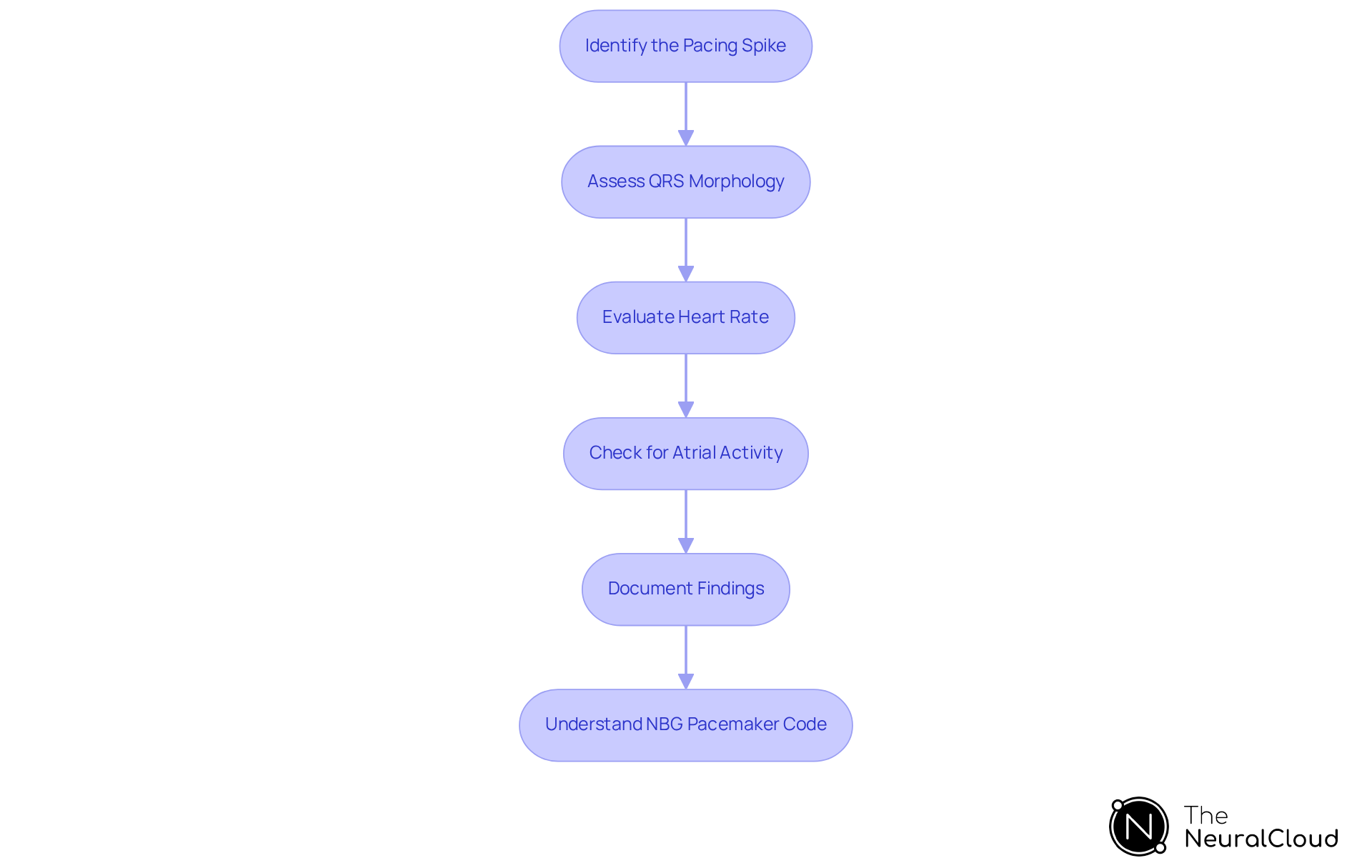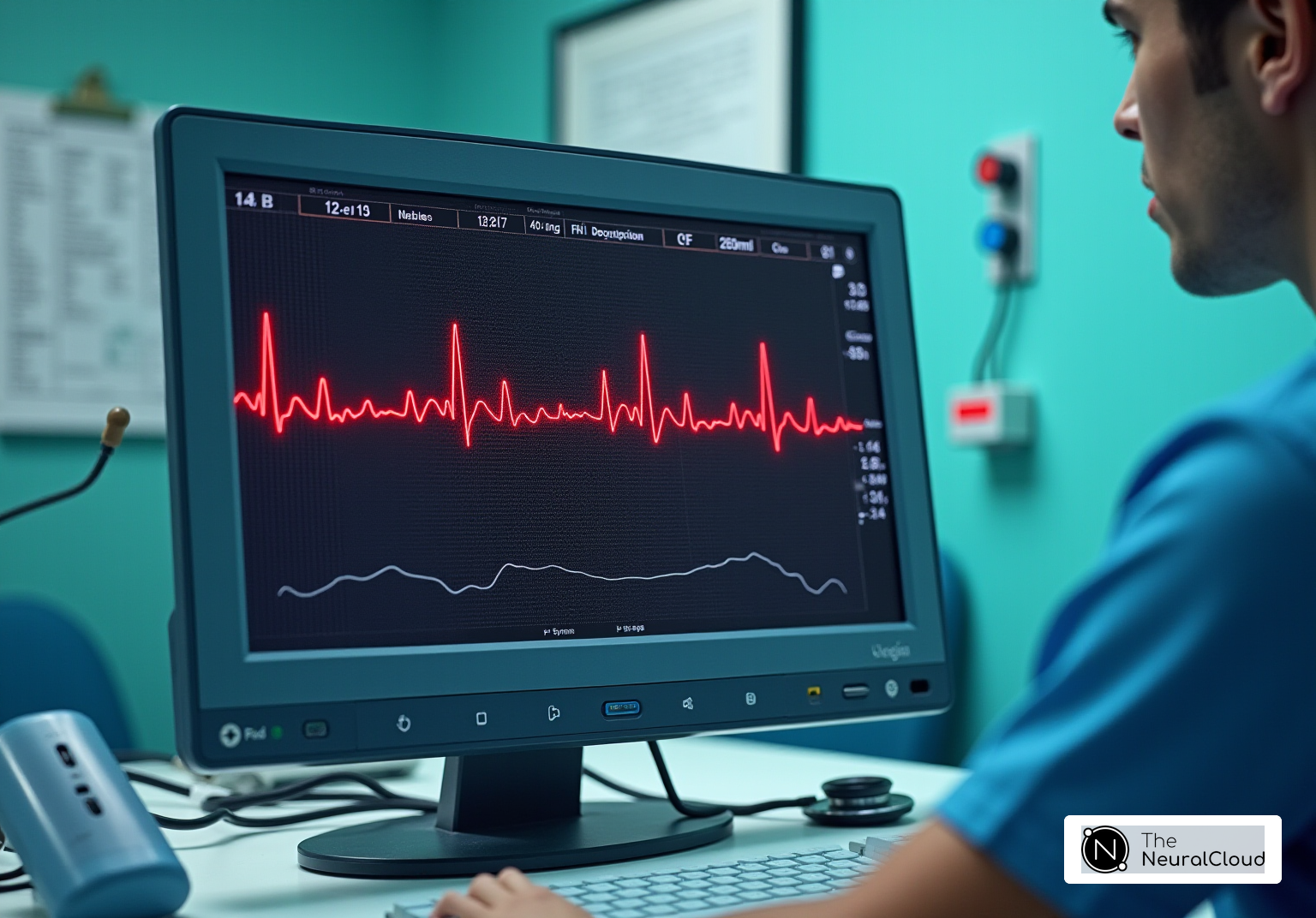Introduction
Understanding the challenges of interpreting ventricular paced rhythm ECGs is crucial for healthcare professionals responsible for monitoring cardiac health. As ECG readings grow more complex, accurately interpreting these vital signals becomes increasingly challenging. This tutorial aims to clarify the key concepts and definitions associated with ventricular pacing, while also introducing the MaxYield™ platform, a powerful tool designed to enhance ECG analysis.
The MaxYield™ platform offers several features that streamline the analysis process. It provides:
- Advanced algorithms for precise signal interpretation
- User-friendly interfaces for easy navigation
- Customizable settings to tailor the analysis to specific needs
These features not only simplify the analysis but also improve the accuracy of diagnoses, ensuring that healthcare professionals can make informed decisions based on reliable data.
By utilizing the MaxYield™ platform, healthcare professionals can experience significant advantages. The platform:
- Enhances efficiency in ECG analysis
- Reduces the likelihood of errors
- Ultimately leads to better patient outcomes
With its comprehensive approach, MaxYield™ empowers users to navigate the complexities of ECG readings with confidence.
Incorporating visual aids such as diagrams or infographics can further enhance understanding, making complex information more accessible. This tutorial will guide you through the essential aspects of ventricular pacing and the benefits of the MaxYield™ platform, ensuring clarity and precision in your ECG analysis.
Clarify Ventricular Paced Rhythm: Key Concepts and Definitions
Ventricular paced rhythm occurs when a pacemaker directly stimulates the ventricles, resulting in a distinct ECG pattern characterized by several key elements:
-
Pacing Spike: This sharp deflection on the ECG indicates the electrical impulse generated by the pacemaker. Identifying a ventricular paced rhythm ECG is crucial, as these spikes precede the QRS complex. MaxYield™ enhances the identification process by quickly isolating and labeling these critical features, even in recordings with high levels of noise and artifact. The QRS complex, which represents ventricular depolarization, is typically wider in a ventricular paced rhythm ECG due to the direct stimulation of the ventricles. This alteration can lead to abnormal ST-T segments, which are essential for accurate ECG interpretation. With MaxYield™, the analysis of QRS complexes is streamlined, allowing for beat-by-beat insights that support confident clinical decisions.
-
Absence of P Waves: In cases of pure ventricular stimulation, P waves are often absent, indicating that the pacemaker is not capturing atrial activity. This absence is a critical indicator of the pacing mode and can suggest underlying conduction issues related to the ventricular paced rhythm ECG. MaxYield™'s advanced noise filtering capabilities ensure that even previously obscured sections of lengthy Holter and patch monitor recordings can be salvaged, providing a clearer picture of the individual's cardiac activity.
Understanding these elements is essential for healthcare professionals, as they directly impact the management of individuals receiving care. Dr. Marco Perez emphasizes that a well-functioning pacemaker should only activate when the heart's natural rhythm falls below a programmed rate or when there's a conduction block. This highlights the importance of observing rhythm spikes and their connection to QRS complexes in clinical practice.
Recent studies indicate that a ventricular paced rhythm ECG is common among cardiac patients, particularly those with bradyarrhythmias. Real-world examples illustrate the significance of pacing spike identification in ECGs, as failure to capture can lead to serious complications, including poor cardiac output. Consistent follow-ups and education on recognizing these patterns can enhance health management and individual confidence. By integrating wearable technology with advanced systems, healthcare professionals can streamline labeling and improve workflow efficiency, ultimately resulting in better outcomes for individuals.

Set Up for ECG Analysis: Equipment and Software Requirements
To effectively analyze ventricular paced rhythm ECGs, it's essential to utilize several key components:
- ECG Machine: A 12-lead ECG machine is recommended for thorough analysis, capturing a comprehensive view of the heart's electrical activity.
- Electrodes: Employ high-quality electrodes designed to minimize noise and ensure optimal contact with the skin. Superior electrodes can significantly reduce noise levels, enhancing the clarity of the ECG signal.
- Software: Advanced ECG analysis software, such as the MaxYield™ platform, is crucial for interpreting the ventricular paced rhythm ECG. This platform automates the identification of pacing spikes and QRS complexes, streamlining the analysis process.
- Calibration Tools: Regular calibration of the ECG machine is vital to maintain accuracy and reliability in readings.
- Preparation of the Individual: Ensure the individual is relaxed and positioned correctly to minimize motion artifacts, which can distort the ECG signal.
Adhering to these guidelines will not only improve the quality of your ECG data but also facilitate accurate interpretation, ultimately leading to better patient outcomes.
The MaxYield™ Advantage
The MaxYield™ platform addresses common challenges in ECG analysis by providing features that enhance the accuracy and efficiency of readings.
Features:
- Automated identification of pacing spikes and QRS complexes.
- User-friendly interface for easy navigation.
- Comprehensive reporting tools for detailed analysis.
Advantages:
- Saves time for healthcare professionals by reducing manual analysis.
- Increases diagnostic accuracy through automated processes.
- Enhances patient care by providing timely and reliable ECG interpretations.
In conclusion, utilizing the MaxYield™ platform not only streamlines the ECG analysis process but also contributes to improved patient outcomes through enhanced accuracy and efficiency.

Analyze Ventricular Paced Rhythm ECG: Step-by-Step Walkthrough
To effectively analyze a ventricular paced rhythm ECG using the MaxYield™ platform, follow these steps:
-
Identify the Pacing Spike: Look for sharp vertical spikes preceding the QRS complexes, indicating pacemaker activity. These spikes are typically 2 ms in duration and vary in amplitude based on lead type and placement.
-
Assess QRS Morphology: Examine the width and shape of the QRS complexes. In the context of ventricular paced rhythm ECG, these complexes are typically broad and frequently resemble left bundle branch block (LBBB) morphology, especially when the lead is positioned in the right ventricle.
-
Evaluate Heart Rate: Calculate the heart rate by measuring the distance between rhythm spikes. A consistent rhythm suggests effective pacing, while irregularities may indicate issues such as failure to capture or under-sensing.
-
Check for Atrial Activity: Confirm the absence of P waves, indicating that the atria are not being paced. In cases of atrial fibrillation, chaotic atrial activity may complicate interpretation.
-
Document Findings: Record your observations, including any irregularities or concerns, to inform clinical decisions. Noting the presence of fusion beats-where paced and native impulses interact-can provide additional insights into the individual's rhythm.
This systematic approach enhances diagnostic accuracy and improves patient outcomes by ensuring that key findings are not overlooked. Integrating the automated labeling and advanced noise filtering features of the platform significantly improves the clarity and efficiency of ECG interpretation, tackling issues such as physiological variability and signal artifacts.
Understanding the NBG Pacemaker Code, which consists of up to five letters indicating various functions of the pacemaker, can provide valuable context for interpreting pacing modes and their implications in ECG analysis. This evolution in ECG analysis is particularly relevant for health tech developers aiming to leverage AI-based models for improved diagnostic outcomes.

Overcome Challenges in ECG Analysis: Noise Reduction and Signal Clarity
To enhance the clarity of ECG signals and minimize noise, consider these effective strategies:
- Electrode Placement: Proper placement and skin preparation are crucial to reduce impedance and motion artifacts.
- Use of Filters: Implement low-pass and high-pass filters to remove high-frequency noise and baseline wander, respectively. The innovative MaxYield™ platform enhances this process with advanced noise filtering, ensuring a clean, 'neuralized' signal that outperforms traditional methods.
- Signal Averaging: Utilize software that averages multiple beats to improve the signal-to-noise ratio. This system automates the process, allowing for rapid data processing and analysis, making it more efficient than conventional approaches.
- Artifact Identification: Learn to recognize common artifacts, such as muscle tremors or electrical interference, and adjust settings accordingly. The MaxYield™ platform assists in identifying these artifacts, streamlining your workflow and improving accuracy compared to standard techniques.
- Regular Maintenance: Regular maintenance and calibration of ECG equipment are essential to prevent technical issues.
By implementing these techniques alongside the capabilities of Neural Cloud Solutions' MaxYield™, healthcare professionals can significantly enhance the quality of ECG readings, leading to more accurate diagnoses.

Conclusion
Understanding the complexities of ventricular paced rhythm ECGs is crucial for healthcare professionals committed to optimal cardiac health. This tutorial clarifies the key elements of ventricular pacing and showcases the MaxYield™ platform's features that enhance ECG analysis.
Challenges in ECG analysis often stem from the difficulty in identifying pacing spikes and assessing QRS morphology. The MaxYield™ platform addresses these challenges by providing high-quality equipment and advanced software, ensuring accurate readings. Effective noise reduction strategies and a systematic approach to ECG analysis significantly improve diagnostic accuracy and patient outcomes.
The integration of advanced tools like MaxYield™ enables healthcare professionals to interpret ECGs with greater confidence and efficiency. By adopting these practices and technologies, improved patient care becomes not just achievable but essential in the dynamic field of cardiac health management. Embracing these insights enhances clinical decision-making and contributes to better health outcomes for individuals with cardiac conditions.
Frequently Asked Questions
What is a ventricular paced rhythm?
A ventricular paced rhythm occurs when a pacemaker directly stimulates the ventricles, resulting in a distinct ECG pattern characterized by pacing spikes and a widened QRS complex.
What is a pacing spike in the context of ventricular paced rhythm?
A pacing spike is a sharp deflection on the ECG that indicates the electrical impulse generated by the pacemaker. It precedes the QRS complex and is crucial for identifying a ventricular paced rhythm.
How does the QRS complex appear in a ventricular paced rhythm ECG?
The QRS complex in a ventricular paced rhythm ECG is typically wider due to the direct stimulation of the ventricles, which can also lead to abnormal ST-T segments.
What does the absence of P waves indicate in a ventricular paced rhythm?
The absence of P waves suggests that the pacemaker is not capturing atrial activity, indicating pure ventricular stimulation and potentially underlying conduction issues.
How does MaxYield™ assist in identifying ventricular paced rhythms?
MaxYield™ enhances the identification process by quickly isolating and labeling critical features like pacing spikes, even in recordings with high levels of noise and artifact, and streamlining the analysis of QRS complexes.
Why is it important for healthcare professionals to understand ventricular paced rhythms?
Understanding these rhythms is essential for managing individuals with pacemakers, as it impacts clinical decisions and can prevent serious complications related to pacing failures.
What are the implications of failing to capture in ventricular paced rhythm?
Failure to capture can lead to serious complications, including poor cardiac output, making it crucial for healthcare professionals to monitor and recognize these patterns.
How can wearable technology improve the management of ventricular paced rhythms?
Integrating wearable technology with advanced systems can streamline labeling and improve workflow efficiency for healthcare professionals, ultimately leading to better outcomes for individuals.






